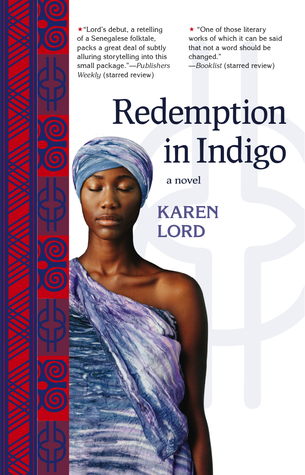by Karen Lord
188pp (Trade Paperback)
My Rating: 8/10
LibraryThing Rating: 3.82/5
Goodreads Rating: 3.83/5
Karen Lord’s debut novel Redemption in Indigo, a fairly short book partially based on a Senegalese folk tale, was nominated for a World Fantasy Award and won several other awards, including the Mythopoeic Fantasy Award for Adult Literature, the Frank Collymore Award, the William L. Crawford Fantasy Award, and the Carl Brandon Parallax Award. It’s a wonderfully written, charming tale, although I really liked it instead of wholeheartedly loving it mainly because I did not think much of the second half was quite as captivating as the superb first part.
A rival of mine once complained that my stories begin awkwardly and end untidily. I am willing to admit to many faults, but I will not burden my conscience with that one. All my tales are true, drawn from life, and a life story is not a tidy thing. [pp.1]
From the very first lines, it’s clear what to expect from Redemption in Indigo. This story, told as though it’s being orally narrated, is somewhat meandering and does not have a straightforward plot line that flows neatly from point A to point B (which is rather fitting considering much of the plot does revolve around the Chaos Stick). Every time I thought I had figured out the main focus of the book, it changed gears. At first, it seems as though it may be a lighthearted humorous story about how Paama discreetly makes the best of the unfortunate situations created by her foolish husband Ansige. After the third time she bails him out of trouble, she’s chosen to wield the Chaos Stick and it seems as though it may actually be the story of her learning to control this newfound power. Shortly after that, the indigo lord learns his power has been given to a mere mortal, and it seems as though it may be the story of his attempts to discover who has it and take it back. This ends up going in a direction I did not at all expect, and the indigo lord ends up being quite different from what I had anticipated from a character who had been explicitly stated to be the villain in this story.
At its heart, Redemption in Indigo is a mythical tale about humanity, chance, choices, and the fleeting moments that can have a lifelong impact. There’s more focus on storytelling than in-depth characterization, and I thought the straightforward style of a narrator speaking to an audience worked. For the most part I enjoyed the voice, but it isn’t particularly subtle since the narrator is very up front and open when providing commentary on the story a few times, including dissecting what it’s really about and the roles of various characters.
Though the characters are not incredibly well fleshed out, the main protagonist is wonderful. Paama is resourceful, compassionate, and dutiful, and some of my favorite parts were those in which she found solutions to the ridiculous situations Ansige got himself into due to his insatiable hunger. Three times she quickly assesses the situation and finds a way to present it that’s completely false but at least attempts to save her husband from appearing foolish (everyone comes to the conclusion he’s foolish anyway after he needs rescuing three days in a row but thinks well of Paama for her grace and tact when dealing with his unfortunate incidents). Paama always strives to do the right thing and is easy to like and root for.
The first half of the book especially brims with humor and wit, and I quite thoroughly enjoyed this part. Though the latter half remains well-written with some memorable and even humorous scenes, it’s more serious overall and I preferred the more lighthearted tone of the previous part. It worked quite well with the writing style and was quite vivid and engaging.
Redemption in Indigo is an enchanting, fairly short folk tale and a strong debut novel, though I did feel that the latter part of the book wasn’t quite as compelling as the superb first half. It’s not my personal favorite of Karen Lord’s books—that would be her thoughtful, engaging science fiction novel The Best of All Possible Worlds—but I found it very much worth reading and admired both the storytelling structure and Paama’s strength of spirit.
My Rating: 8/10 (averaged since the first half was a 9 and the second was a 7)
Where I got my reading copy: I purchased it.
This book is June’s selection from a poll on Patreon.














